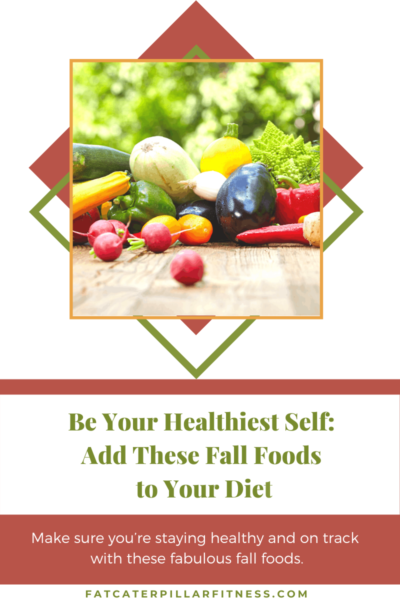Fall is such an exciting season, especially when it comes to everything about food. The fall harvest gives you the chance to enjoy delicious meals like pies, soufflés, chilies, bisques, and so much more. With the weather getting cooler, nothing sounds better than curling up with a nice hot plate of these comfort foods. But the typical comfort food we feast on at this time of year can be laden with extra calories.
That’s why I’m sharing with you my top picks for healthy fall foods you should eat. Stick with these, and you’ll find it is, in fact, possible for you to eat healthily this season!
The fall is that time of the year when you get to see assortments of colorful root vegetables and crisp fruits. Introducing these will not only help you eat healthy this fall, but also enjoy what you eat. It’s really easy and fun to go to local markets and stores to pick out fresh seasonal produce. So, pick a date and make a plan to go shopping!
Before you head out to the market, take a look at my list of healthy fall foods you should eat:
Blueberries
Blueberries are available all year round, but some of the best varieties are available during the fall. They carry lots of nutritional benefits, including high fiber, antioxidants, and vitamin C.
Blueberries also can help lower blood pressure and protect against cholesterol damage. When the temperature drops, you’ll want to substitute your summer desserts with something equally delicious, but also good for you.
Try adding them to main course meals like turkey and pork to sauce it up.
Cranberries
Cranberries are delicious (they’re my FAVOURITE!), so it’s always a great idea to include them in your meals when they’re in season. They add sweetness to a variety of dishes like desserts, oatmeal, and pancakes, all while keeping sugar levels low.
They’re a great source of fiber, manganese, and tons of vitamins. And cranberries contain antioxidants that can help fight infections.
Try adding them to grains like brown rice and quinoa for a fun twist to your usual side dishes.
Apples
In any season, apples are quite hard to miss. In fall, they are beyond abundant. They come in many colorful varieties, which all have unique tastes.
They are a very healthy fruit, as they contain soluble fiber, which helps lower cholesterol. Apples are also shown to lower your risk of diabetes and promote good gut bacteria.
Every time you hit the stores, try out a different variety. You’ll be stunned by the flavors when you add them to your morning oatmeal. They’re easy to store as well.
Apples can be high in natural fruit sugars, however, so watch your portions! Stick to one medium apple per day for the best benefits.
Pears
Like apples, pears are high in fiber with minimal calories. They have anti-inflammatory properties and can boost heart health with their highly nutritious vitamins.
Pears blend perfectly with a lot of cooked meals and are great additions for salads. It’s best if you buy them before they’re ripe because they will soften after only a few days.
Pomegranates
Pomegranates are extremely healthy. Eating pomegranate is also exciting! You can crack them open, take out the seeds, and consume them whole.
Pomegranate juice is also delicious and full of health benefits. Plus, they help prevent fat from building up in your arteries.
Eat them just as they are for a snack, add them to salads, or use them as a topping for yogurt.
Butternut Squash
Butternut Squash is a staple of fall cooking. It’s versatile and very nutritious, so you can use it in so many ways this fall. This food is excellent for staying healthy this season because it’s low in calories, but very dense with nutrients.
It has many of the essential vitamins and minerals your body needs, like Vitamin C, A, E, and B. Butternut Squash is also a source of antioxidants and high in fiber.
It’s super easy to make in a ton of meals or even in a pie.
I have the perfect way to incorporate this delicious gourd to your fall menu. Click here to check out my Butternut Squash Harvest Bowl!
Broccoli
Broccoli is a cruciferous vegetable that is plentiful in the fall. It can be eaten in a number of ways, such as steaming, roasting, or you can even whip it in a stir-fry.
They come with numerous health benefits from their vitamins, minerals, and bioactive compounds. Broccoli is filled with Vitamin K, Folate, Potassium, and Vitamin C that promotes heart health and reduced inflammation.
Some people don’t like eating broccoli (who knows why, it’s awesome!), but you can get creative by adding it to a soup, cooking it with white beans, or topping with a little melted cheese.
Leeks
Leeks do the same job as onions, but are milder and sweeter in flavor. You’ll see a lot of them at the supermarket during fall. They don’t just make meals pretty and delicious, they also provide Vitamin K, which strengthens bones and helps prevent cancer.
This season, use them in place of onions in your favorite recipes.
Give Them A Try
Fall is the perfect time to experiment with new recipes or foods you’ve never tried. All of the foods above have significant health benefits and nutrients that will keep you satisfied and feeling your best this season. Mix these up and try pairing them with different sources of protein and fats to create some fantastic fall meals.
Share with us in the comments down below some ways you love using these foods. We’d love to hear your ideas!



